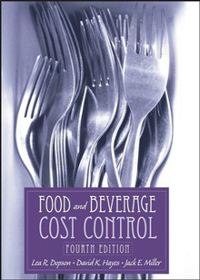Preface.
Acknowledgements.
Before You Start: How to Use Spreadsheets.
Chapter 1. Managing Revenue and Expense.
Professional Foodservice Manager.
Profit: The Reward for Service.
Getting Started.
Understanding the Profit and Loss Statement.
Understanding the Budget.
Key Terms and Concepts.
Apply What You Have Learned.
Test Your Skills.
Chapter 2. Determining Sales Forecasts.
Importance of Forecasting Sales.
Sales History.
Maintaining Sales Histories.
Sales Variances.
Predicting Future Sales.
Technology Tools.
Apply What You Have Learned.
Key Terms and Concepts.
Test Your Skills.
Chapter 3. Managing the Cost of Food.
Menu Item Forecasting.
Standardized Recipes.
Inventory Control.
Purchasing.
Receiving.
Storage.
Determining Actual Food Expense.
Technology Tools.
Apply What You Have Learned.
Key Terms and Concepts.
Test Your Skills.
Chapter 4. Managing the Cost of Beverages.
Serving Alcoholic Beverages.
Forecasting Beverage Sales.
Standardized Drink Recipes and Portions.
Purchasing Beverage Products.
Receiving Beverage Products.
Storing Beverage Products.
Bar Transfers.
Computing Cost of Beverages.
Special Features of Liquor Inventory.
Sales Mix.
Technology Tools.
Apply What You Have Learned.
Key Terms and Concepts.
Test Your Skills.
Chapter 5. Managing the Food and Beverage Production Process.
Managing the Food and Beverage Production Process.
Product Issuing.
Inventory Control.
Managing the Food Production Area.
Managing the Beverage Production Area.
Employee Theft.
Determining Actual and Attainable Product Costs.
Reducing Overall Product Cost Percentage.
Technology Tools.
Apply What You Have Learned.
Key Terms and Concepts.
Test Your Skills.
Chapter 6. Managing Food and Beverage Pricing.
Menu Formats.
Factors Affecting Menu Pricing.
Assigning Menu Prices.
Special Pricing Situations.
Technology Tools.
Apply What You Have Learned.
Key Terms and Concepts.
Test Your Skills.
Chapter 7. Managing the Cost of Labor.
Labor Expense in the Hospitality Industry.
Evaluating Labor Productivity.
Maintaining a Productive Workforce.
Measuring Current Labor Productivity.
Managing Payroll Costs.
Reducing Labor-Related Costs.
Technology Tools.
Apply What You Have Learned.
Key Terms and Concepts.
Test Your Skills.
Chapter 8. Controlling Other Expenses.
Managing Other Expenses.
Fixed, Variable, and Mixed Other Expenses.
Controllable and Noncontrollable Other Expenses.
Monitoring Other Expenses.
Reducing Other Expenses.
Technology Tools.
Apply What You Have Learned.
Key Terms and Concepts.
Test Your Skills.
Chapter 9. Analyzing Results Using the Income Statement.
Introduction to Financial Analysis.
Uniform System of Accounts.
Income Statement (USAR).
Analysis of Sales/Volume.
Analysis of Food Expense.
Analysis of Beverage Expense.
Analysis of Labor Expense.
Analysis of Other Expenses.
Analysis of Profits.
Technology Tools.
Apply What You Have Learned.
Key Terms and Concepts.
Test Your Skills.
Chapter 10. Planning for Profit.
Financial Analysis and Profit Planning.
Menu Analysis.
Cost/Volume/Profit Analysis.
The Budget.
Developing the Budget.
Monitoring the Budget.
Technology Tools.
Apply What You Have Learned.
Key Terms and Concepts.
Test Your Skills.
Chapter 11. Maintaining and Improving the Revenue Control System.
Revenue Security.
External Threats to Revenue Security.
Internal Threats to Revenue Security.
Developing the Revenue Security System.
The Complete Revenue Security System.
Technology Tools.
Apply What You Have Learned.
Key Terms and Concepts.
Test Your Skills.
Chapter 12. Global Dimensions of Management & the Role of Technology.
Multi-national Foodservice Operations.
Management Challenges in a Global Economy.
Advances in Technology and Information Management.
Selecting Advanced Technology Products.
Monitoring Developments in Cost Control Technology.
Apply What You Have Learned.
Key Terms and Concepts.
Test Your Skills.
Appendix A. Frequently Used Formulas for Managing Operations.
Appendix B. Management Control Forms.
Appendix C. Fun on the Web! Sites.
Glossary.
Bibliography.
Inde












